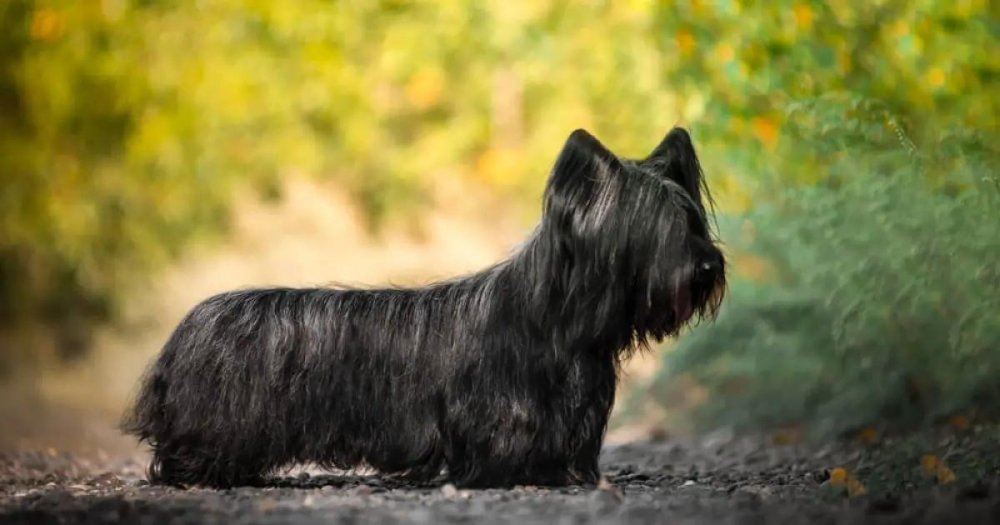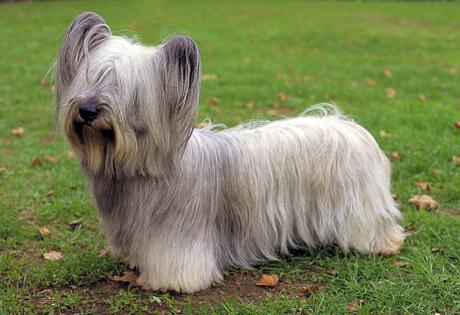- Breed Category: Terrier
- Country of Origin: Scotland
- Average Height: 25-26 cm (9.8-10.2 in)
- Average Weight: 8-10 kg (17.6-22 lbs)
- Average Life Span: 12-14 years
- Grooming Requirements: Regular brushing needed
- Exercise Requirements: Moderate daily exercise
- Coat Type: Long, straight, and flat
- Coat Color Variations: Black, blue, grey, fawn
- Shedding Level: Low
- Ear Type: Erect or drop ears
- Tail Type: Feathered and carried low
- Temperament: Loyal, affectionate, and fearless
- Intelligence Level: High
- Barking Tendency: Moderate
- Compatibility with Children: Good with older children
- Compatibility with Other Pets: Can be territorial
- Training Ease: Requires patience and consistency
- Common Health Issues: Hip dysplasia, allergies
- Dietary Needs: Balanced diet, avoid overfeeding
- Energy Level: Moderate
- Drooling Tendency: Low
- Sensitivity to Weather: Sensitive to heat
- Overall Maintenance Level: Moderate
- Original Purpose: Hunting and vermin control
- Year of Recognition by Kennel Clubs: 1887
- Famous Breed Representatives: Greyfriars Bobby
- Apartment Friendly: Yes, with sufficient exercise
- Best Suited For: Families, singles, experienced owners
- Cost of Ownership: Moderate
- Unique Traits: Long body, short legs
- Cultural Significance: Featured in Scottish folklore
- Popularity Rank: Less common
Think all terriers are the same? Let’s dive into the unique world of the Skye Terrier. This breed stands out with its long, flowing coat and distinct personality. Known for their loyalty and courage, Skye Terriers are more than just a pretty face. They have a rich history that dates back to the Isle of Skye in Scotland, where they were bred to hunt foxes and badgers. This article aims to inform you about their fascinating characteristics, storied past, and how best to care for them. Understanding their origins helps appreciate their unique traits and needs. So, whether you’re a potential owner or just curious, let’s explore what makes the Skye Terrier truly special.
The Skye Terrier: A Storied Past and Distinctive Traits

Early Development of the Breed
The Skye Terrier’s journey began on the rugged Isle of Skye, where its ancestors were bred for their tenacity and hunting prowess. These dogs were developed to tackle the challenging Scottish terrain, making them adept at hunting foxes and badgers. Their long, flowing coats were not just for show; they provided essential protection against the harsh weather conditions of the region.
Role in Scottish History and Culture
In Scotland, the Skye Terrier became a symbol of loyalty and bravery. They were cherished by the Scottish nobility, often seen as companions to the elite. Their presence in Scottish folklore and stories highlights their importance in the cultural tapestry of the nation.
Key Historical Figures
One notable figure in the breed’s history is Queen Victoria, who was an avid admirer of the Skye Terrier. Her fondness for the breed helped elevate its status and popularity across Britain, cementing its place in history.
Physical Characteristics
Skye Terriers are easily recognisable by their long, silky coats and distinctive, feathered ears. They have a sturdy build, with a body that is longer than it is tall, giving them a unique silhouette. Despite their elegant appearance, they are robust and agile, perfectly suited for their original role as hunters.
Appearance and Unique Physical Traits
Skye Terriers are a sight to behold with their long, flowing coats that drape elegantly over their sturdy frames. Their coats come in a variety of colours, including black, blue, grey, silver, fawn, and cream, often with darker ears and muzzles. These distinctive feathered ears can either stand erect or drop, adding to their unique charm. Their bodies are longer than they are tall, giving them a low, elongated silhouette that’s both striking and functional for their original hunting purposes.
Temperament and Behaviour
When it comes to personality, Skye Terriers are a delightful mix of loyalty and independence. They form strong bonds with their families, often showing a reserved nature towards strangers. Despite their dignified appearance, they have a playful side and enjoy engaging in activities that challenge their minds. These terriers are known for their courage and tenacity, traits that served them well in their hunting days. While they can be a bit stubborn, their intelligence makes them highly trainable with the right approach.
Skye Terrier as a Family Pet

Typical Personality Traits
Skye Terriers are known for their loyalty, courage, and independence. These traits make them excellent companions for those who appreciate a dog with a strong character. They are fiercely loyal to their families and often form deep bonds with their owners. While they can be reserved with strangers, their courage shines through in their protective nature.
Suitability as a Family Pet and Companion
As a family pet, the Skye Terrier is a wonderful choice for those who can appreciate its unique personality. They thrive in environments where they are treated as part of the family. Their independent streak means they are not overly demanding, but they do enjoy being involved in family activities.
Interaction with Children and Other Animals
Skye Terriers generally get along well with children, especially if they are raised together. They are patient and can be playful, making them good companions for kids. However, their interactions with other animals can vary. Early socialisation is key to ensuring they coexist peacefully with other pets.
Training and Exercise Needs
Training a Skye Terrier requires patience and consistency. Their intelligence makes them quick learners, but their independent nature can sometimes lead to stubbornness. Positive reinforcement techniques work best. Regular exercise is important to keep them healthy and happy. They enjoy walks and playtime, which also helps to stimulate their minds.
Training, Exercise, and Health of the Skye Terrier

Importance of Early Training and Socialisation
Getting a Skye Terrier off to a good start with early training and socialisation is crucial. These dogs are intelligent but can be a bit headstrong, so introducing them to various environments, people, and other animals early on helps shape a well-rounded adult dog. This early exposure helps curb any potential stubbornness and encourages a more adaptable temperament.
Recommended Training Techniques
When it comes to training, patience and consistency are your best friends. Skye Terriers respond well to positive reinforcement techniques, like treats and praise. Keep training sessions short and engaging to hold their attention. Remember, they’re smart cookies, so mix things up to keep them interested.
Daily Exercise Requirements and Activities They Enjoy
Skye Terriers need regular exercise to stay fit and happy. Daily walks are a must, but they also love a good play session. Activities that challenge their minds, like puzzle toys or agility courses, are great for keeping them entertained. They’re not just about physical exercise; mental stimulation is key too.
Health and Lifespan
Generally, Skye Terriers are a healthy breed with a lifespan of around 12 to 14 years. Regular vet check-ups and a balanced diet are essential to keep them in top shape. Like all breeds, they can be prone to certain health issues, so staying informed and proactive about their health is important.
Health and Care for the Skye Terrier

Common Health Issues
Skye Terriers are generally healthy, but like any breed, they have their share of health concerns. They can be prone to issues like hip dysplasia and certain eye conditions. Regular vet visits are crucial to catch any potential problems early. Keeping an eye on their weight is also important, as obesity can exacerbate joint issues.
Average Lifespan and Health Tips
With proper care, Skye Terriers typically live between 12 to 14 years. To ensure they enjoy a long, healthy life, provide a balanced diet and regular exercise. Mental stimulation is just as important as physical activity, so engage them with interactive toys and training sessions.
Preventative Care Recommendations
Preventative care is key to maintaining your Skye Terrier’s health. Regular vaccinations, flea and tick prevention, and dental care should be part of their routine. Annual vet check-ups help monitor their overall health and catch any issues early.
Grooming and Maintenance
Their long, flowing coats require regular grooming to prevent matting and tangles. Brush them a few times a week and bathe them as needed. Pay attention to their ears, as they can be prone to infections. Regular ear cleaning and nail trimming are also essential parts of their grooming routine.
Coat Care and Grooming Routines

Shedding and Seasonal Grooming Tips
Skye Terriers boast a stunning coat that requires regular attention. Their long, silky hair can easily tangle, so brushing a few times a week is essential. During shedding seasons, which typically occur in spring and autumn, you might need to increase the frequency to manage loose hair and prevent matting. A good quality brush and a detangling spray can make this task easier and more effective.
Diet and Nutrition
Feeding your Skye Terrier a balanced diet is crucial for maintaining their health and vitality. High-quality dog food that meets their nutritional needs is a must. Look for options rich in protein and healthy fats, as these support their energy levels and coat condition. Avoid overfeeding, as Skye Terriers can be prone to weight gain, which can lead to joint issues. Fresh water should always be available, and occasional treats can be used for training and rewards, but keep them in moderation.
Nutritional Needs and Feeding Guidelines for Skye Terriers
Nutritional Needs for Optimal Health
Skye Terriers thrive on a diet rich in high-quality proteins and healthy fats. These nutrients support their energy levels and help maintain their luxurious coats. Look for dog food that lists meat as the first ingredient, ensuring it meets their dietary requirements.
Foods to Include and Avoid
Include lean meats, fish, and vegetables in their diet. These provide essential vitamins and minerals. Avoid foods high in fillers, artificial additives, and excessive grains, as these can lead to digestive issues and weight gain.
Feeding Schedules and Portion Recommendations
Feed your Skye Terrier twice a day, once in the morning and once in the evening. Portion sizes depend on their age, weight, and activity level, so consult your vet for specific recommendations. Avoid free-feeding to prevent overeating.
Fun Facts and Trivia
Did you know that Skye Terriers were once so popular that they were mentioned in Shakespeare’s “Macbeth”? Their unique appearance and loyal nature have made them a favourite among dog enthusiasts for centuries.
Famous Skye Terriers in Media and History
Notable Skye Terriers
Skye Terriers have left their paw prints in history and media, capturing hearts with their unique charm. One of the most famous Skye Terriers is Greyfriars Bobby, a loyal dog from Edinburgh who famously guarded his owner’s grave for 14 years. His story of devotion was so touching that it inspired books and films, making him a symbol of loyalty worldwide.
Skye Terriers in Literature and Film
These terriers have also made appearances in literature and film. Their distinctive look and spirited nature have made them a favourite choice for storytellers. In Shakespeare’s “Macbeth,” Skye Terriers are mentioned, highlighting their historical presence and popularity even in the 17th century.
Royal Connections
Queen Victoria’s fondness for Skye Terriers further cemented their status. Her admiration for the breed helped boost their popularity during her reign, making them a fashionable choice among the British elite. This royal connection added a touch of prestige to the breed, enhancing their allure.
Final Thoughts

The Skye Terrier is a unique blend of elegance and tenacity. This breed’s rich history and distinctive traits make it a fascinating companion for those who appreciate its loyal and independent nature. While they require consistent training and grooming, the rewards of owning a Skye Terrier are immense, offering both companionship and a touch of Scottish heritage. Embrace the journey of caring for this remarkable breed, and you’ll find a loyal friend for life. Consider welcoming a Skye Terrier into your home and experience the joy they bring.
